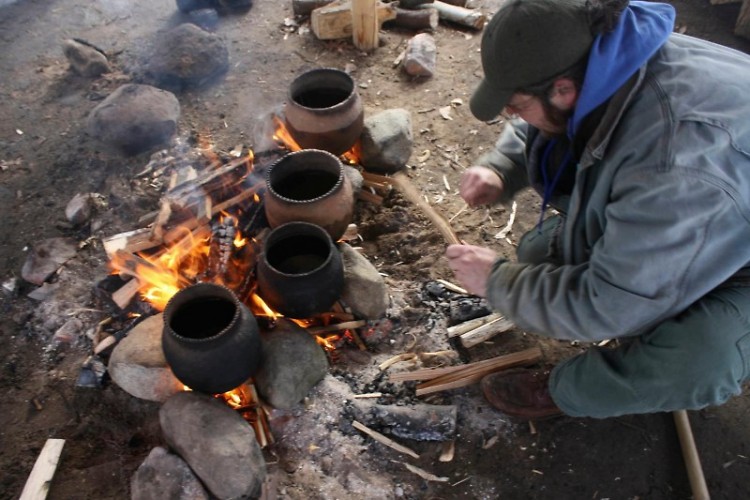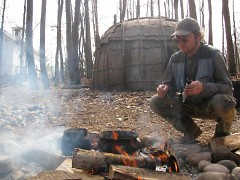Students of Blandford School and Goodwillie Environmental School helped a research team to figure out the historically accurate way that Native Americans may have made maple sugar from tree sap, and the findings may change the way that hundreds of nature centers nationally demonstrate maple sugaring.
Based on research by the Great Lakes Lifeways Institute in Allegan County, Mich., the Blandford Nature Center in Grand Rapids already has eliminated the demonstration that shows Native Americans making maple syrup by boiling the sap from sugar maple trees using hot rocks dropped into hollowed-out logs.
"When you try to boil down sap that way, it yields a sooty and strongly alkaline mixture that can literally remove the hair from animal hide," says Kevin Finney, executive director of the institute. "There isn't any historical accuracy in that demonstration."
The institute enlisted the aid of students at Blandford and Goodwillie in some of the field research that compared the hot rocks-log technique with the use of unglazed pottery to boil down sap.
"Students from Blandford and Goodwillie have helped conduct field research that has proven maple sugar can be made in unglazed, open-fired earthenware pottery that was used by ancient people around here,” says Erik Vosteen, institute project manager who conducted and directed the research. "This is significant since science journals have have been debating this question for 150 years, and no one has ever actually replicated the pottery and tried to make sugar with it."
Nature centers across the country often show the pre-industrial evolution of how sugar was made from maple tree sap, starting with Native Americans and the hot rock-log technique, then European settlers happily stirring large kettles of boiling sugar maple sap over an open fire, with a final demonstration of how it is made today.
Finney says it would be more accurate to ditch the hot-rock method and replace European settlers with Native Americans who tend to the process. That certainly would be true in Michigan.
It turns out that maple sugaring was a truly big business for Native Americans in our state. Federal records show that tribes in Michigan produced more than 1 million pounds of maple sugar in 1847, partly because abolitionists bought maple sugar since they didn't believe in supporting cane sugar produced through slave labor, according to Finney. When maple sugar production peaked just before the Civil War, tribes and farmers in Michigan were producing annually more than six times what we produce today.
"The actual story is we don't know if Native Americans ever made maple sugar before the arrival of the Europeans," he says. "There are a couple of accounts in the early 1600s of Native Americans collecting sap to make a sweet liquid, but it's clear that they didn't put a major stop in their seasonal cycles of life to do maple sugaring at that time."
The research shows that Native Americans hundreds of years ago may have boiled sap in unglazed clay pots, but there isn't any solid evidence that maple sugaring was a widespread practice. "The native people may have mastered ways to concentrate the sap, but the question is whether they really spent their time doing that," Finney says.
Vosteen says the institute backs up its assertions with a lot of painstaking work that also involved researchers from Grand Valley State University and Indiana University. Grade schoolers and researchers showed that the hot rock-and-log method yields only a thoroughly inedible chemical mixture that has enough lye from wood ashes to make soap. So the institute examined other methods of concentrating sugar maple sap by using unglazed clay pots for boiling or even allowing the sap to freeze, then removing the ice that contains largely water.
Paul Stuery, education coordinator at the Merry Lea Environmental Learning Center of Goshen College, Wolf Lake, Ind., agrees that a new approach needs to be taken in explaining how sugaring was conducted historically.
“There is a huge need for accurate and updated interpretive guidelines for educators” says Stuery, who runs one of the largest sugaring educational programs in the Great Lakes region. “Many educational programs are forced to resort to the ‘old standby’ demonstrations and stories that we now know to be incorrect, simply because there is currently no source for compiled and accurate research.”
Vosteen is looking to implement the next phase of research that involves lab analysis of pottery used in the open-fire sugaring process to see if the technique leaves any chemical traces. If a chemical fingerprint can be identified, the standard may be used to determine if sugaring ever occurred at the DeBoer site in Allegan County where archeologists have found quantities of pottery shards.
Finney’s team has begun to compile research for an interpretive guidebook and DVD that he hopes to publish for nature centers across the country that will correct the historical inaccuracies about maple sugaring by Native Americans and settlers. "Sugar bush demonstrations are often the largest drawing events for nature centers, and they are still showing the standard models that are just wrong," Finney says. "They want to be able to present accurate material, but they just don't have the resources. We hope to give them that."
The Rapidian, a program of the 501(c)3 nonprofit Community Media Center, relies on the community’s support to help cover the cost of training reporters and publishing content.
We need your help.
If each of our readers and content creators who values this community platform help support its creation and maintenance, The Rapidian can continue to educate and facilitate a conversation around issues for years to come.
Please support The Rapidian and make a contribution today.


